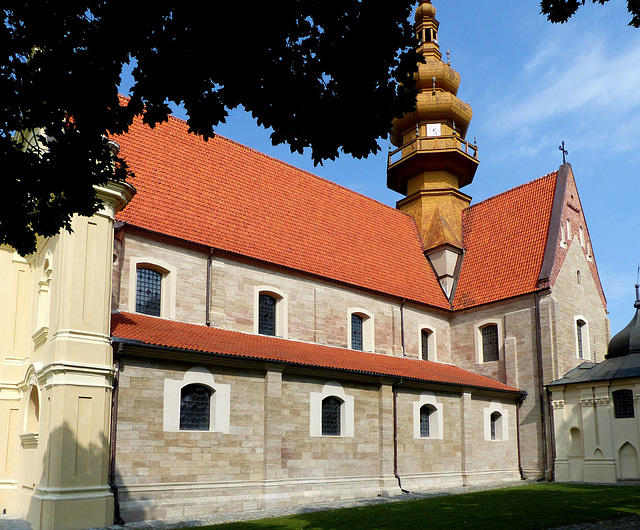Location
Lat, Lng:
Lat, Lng:
You can copy the above to your favourite mapping app.
Address: unknown
Lat, Lng:
You can copy the above to your favourite mapping app.
Address: unknown
See also...
Keywords
Authorizations, license
-
Visible by: Everyone -
All rights reserved
-
47 visits
Koprzywnica - Opactwo Cystersów


Koprzywnica today is a small town that developed from a settlement in the 12th century. In 1185 Casimir II the Just brought the Cistercians here, who founded a monastery (26. filiation of Morimond).
Koprzywnica received town rights in 1268. Thanks to the Cistercians, the town flourished over the next centuries. In 1606 Koprzywnica was one of the centers of the armed uprising of the nobility against Zygmunt III Waza. In the 1660s Koprzywnica was destroyed during the Swedish invasion of Poland. The town never recovered from the losses.
In 1942 the Koprzywnica ghetto was liquidated by the German occupiers when 1,800 Jews were transported from here to the Treblinka extermination camp, where they were murdered.
-
In 1185 Cistercian monks from Morimond, arrived here. The complex was built between 1218 and 1238 by a Cistercian workshop probably from Italy.
The monastery got devasted and looted during the Mongol invasions in 1241and again in 1259. Bolesław V the Chaste was very supportive during the reconstruction and granted the monks numerous privileges.
At the beginning of the 14th century, a reconstruction of the monastery was carried out, followed by renovations a century later, when the new brick cloisters were built. In 1508 the church and monastery were damaged by fire. The damage was rebuilt
Just a century before its dissolution modernization works were carried out, which gave the monastery Baroque elements, including the new, facade of the church.
In 1819 the tsarist authorities issued a decree of cassation of the monastery. After the abbey was dissolved in 1821, the church was taken over by the diocese and has since served as a parish church. Since the buildings were not used, their condition rapidly deteriorated. As a result, most of the monastery buildings were demolished, the main purpose being to obtain building materials. After a fire during WWI, the monastery was demolished except for the east wing and the church. After WWII, renovation works were carried out from 1948 to 1949. The tower was rebuilt in the style of the original in the 1960s.
From this point of view one can see that the baroque façade was added to the medieval structure of the basilica. The reconstructed crossing tower is also from the Baroque period.
Koprzywnica received town rights in 1268. Thanks to the Cistercians, the town flourished over the next centuries. In 1606 Koprzywnica was one of the centers of the armed uprising of the nobility against Zygmunt III Waza. In the 1660s Koprzywnica was destroyed during the Swedish invasion of Poland. The town never recovered from the losses.
In 1942 the Koprzywnica ghetto was liquidated by the German occupiers when 1,800 Jews were transported from here to the Treblinka extermination camp, where they were murdered.
-
In 1185 Cistercian monks from Morimond, arrived here. The complex was built between 1218 and 1238 by a Cistercian workshop probably from Italy.
The monastery got devasted and looted during the Mongol invasions in 1241and again in 1259. Bolesław V the Chaste was very supportive during the reconstruction and granted the monks numerous privileges.
At the beginning of the 14th century, a reconstruction of the monastery was carried out, followed by renovations a century later, when the new brick cloisters were built. In 1508 the church and monastery were damaged by fire. The damage was rebuilt
Just a century before its dissolution modernization works were carried out, which gave the monastery Baroque elements, including the new, facade of the church.
In 1819 the tsarist authorities issued a decree of cassation of the monastery. After the abbey was dissolved in 1821, the church was taken over by the diocese and has since served as a parish church. Since the buildings were not used, their condition rapidly deteriorated. As a result, most of the monastery buildings were demolished, the main purpose being to obtain building materials. After a fire during WWI, the monastery was demolished except for the east wing and the church. After WWII, renovation works were carried out from 1948 to 1949. The tower was rebuilt in the style of the original in the 1960s.
From this point of view one can see that the baroque façade was added to the medieval structure of the basilica. The reconstructed crossing tower is also from the Baroque period.
kiiti has particularly liked this photo
- Keyboard shortcuts:
Jump to top
RSS feed- Latest comments - Subscribe to the comment feeds of this photo
- ipernity © 2007-2024
- Help & Contact
|
Club news
|
About ipernity
|
History |
ipernity Club & Prices |
Guide of good conduct
Donate | Group guidelines | Privacy policy | Terms of use | Statutes | In memoria -
Facebook
Twitter

Sign-in to write a comment.